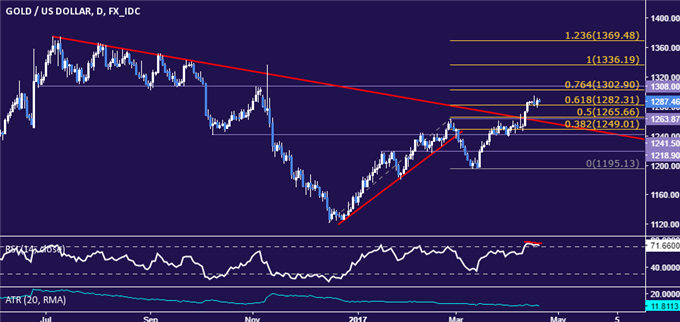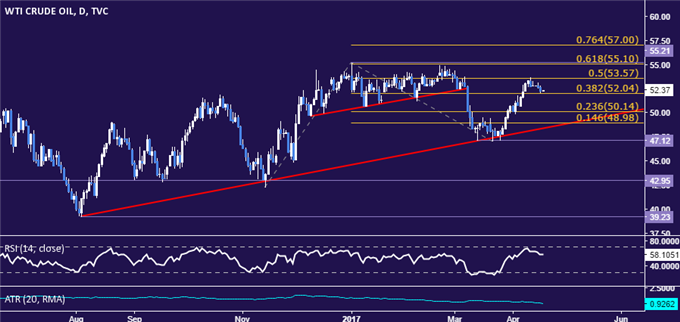Talking Points:
- Crude oil prices drop even as Saudi exports hit two-year low
- Gold prices rise as risk aversion cools Fed rate hike outlook
- Risk appetite, Beige Book, EIA data vie for influence ahead
Crude oil prices fell even as JODI data showed that exports from Saudi Arabia – a bellwether for OPEC – fell to the lowest level in almost two years in February. While that might have been expected to boost confidence in the cartel’s production cut scheme, investors seemed more concerned with signs that growing swing supply may offset coordinated output reduction.
On that front, API reported that US inventories shed 840k barrels last week, less than the 1.03 million barrel drawdown expected to be reported in official EIA data due today. Prices may continue to move downward if that outcome registers closer to API’s projection. Comments from industry bigwigs from the sidelines of the GCC Petroleum Media Forum in Abu Dhabi may also prove market-moving.
Gold prices rose as Federal Reserve rate hike bets deteriorated, boosting the appeal of non-interest-bearing assets. Treasury bond yields fell with the priced-in 2017 tightening path implied in Fed Funds futures and the US Dollar. Risk aversion swept European and US exchanges, sending capital fleeting to the haven of government bonds and casting doubt on the Fed’s appetite for stimulus withdrawal amid market turmoil.
The spotlight will be on the Fed Beige Book survey from here. The markets have grown worried about slowing growth in the first quarter so sanguine-sounding report that seems to keep the US central bank on track to deliver the expected three rate hikes this year may offer a lift to the US Dollar. Boston Fed President Eric Rosengren – a vocal proponent of rate hikes – is also scheduled to speak.
Needless to say, sentiment trends and their knock-on effects on yields remain an important consideration. S&P 500 index futures are on the rebound ahead of the opening bell in Europe. As one might expect, Treasury bond rates and the greenback are following suit. This bodes ill for the yellow metal if it continues, but it may yet be that Asia-session price action is merely corrective before another risk-off wave batters markets.
What will shape crude oil and gold price trends through mid-year? See our forecasts to find out!
GOLD TECHNICAL ANALYSIS – Early signs of negative RSI divergence hint gold prices may be readying to turn lower. A daily close below the 61.8% Fibonacci expansion at 1282.31 opens the door for a retest of the 1263.87-65.66 area (50% level, February 27 high). Alternatively, a move above the 1302.90-08.00 zone (76.4% Fib, former support) exposes the 100% expansion at 1336.19.

Chart created using TradingView
CRUDE OIL TECHNICAL ANALYSIS – Crude oil prices edged lower but failed to crack support at 52.04, the 38.2% Fibonacci expansion. A daily close below this barrier paves the way for another challenge of the 23.6% level at 50.14. Alternatively, a reversal upward that takes prices beyond the 50% Fibat 53.57 sees the next upside barrier in the 55.10-21 area (January 3 high, 61.8% expansion).

Chart created using TradingView
--- Written by Ilya Spivak, Currency Strategist for DailyFX.com
To receive Ilya's analysis directly via email, please SIGN UP HERE
Contact and follow Ilya on Twitter: @IlyaSpivak






